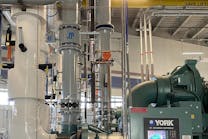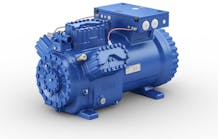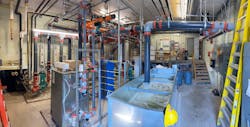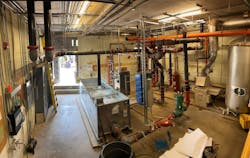Case Study by Victaulic
The core mission at Roosevelt Elementary School in Hays, Kansas, is to support students in pursuing their fullest academic and socioemotional potential. Unfortunately, after nearly 60 years of use, the school’s aging HVAC system was experiencing significant issues, resulting in uncomfortable learning environments for students and teachers.
In 2020, the Hays Unified School District selected local contractor Glassman Corporation to upgrade the heating and cooling system as part of a $21.3-million renovation at Roosevelt Elementary. The new water source heat pump system would include 44 zones to provide individual classrooms with localized temperature control.
The overall goal was to welcome Roosevelt Elementary School students back from summer break a few months later, but the project's success depended on Glassman's ability to overcome several hurdles. The contractor needed solutions to quickly install the piping system and to maximize the existing space without compromising the strict installation timeline.
Glassman enlisted the help of Wichita-based Integrated Consulting Engineers and Victaulic, a national producer of mechanical pipe-joining solutions, based in Easton PA.
Partnership Built for Success
Since the original HVAC system used wall-mounted unit ventilators to provide temperature control, Glassman needed to completely renovate the school’s HVAC and electrical systems. The new system would include water source heat pumps, a cooling tower, a high-efficiency boiler, heat exchangers, a two-pipe loop system and ductwork throughout the building. In addition to these upgrades, the facility received new Direct Digital Controls (DDCs) for all new equipment.
Partnering with Victaulic was a strategic decision to boost installation efficiency at the job site. After all, the Roosevelt Elementary School project was not the contractor’s first experience with Victaulic products.
“We had been utilizing Victaulic for more and more projects throughout Kansas. We are sold on the effectiveness and efficiency of the products,” said Joseph Glassman, President and CEO of Glassman Corporation. “Since we have a background using Victaulic products, we knew this would save us time, which would help us reach our project goal.”
With years of experience working together on previous projects, contractor Glassman felt confident in its ability to meet the project’s demands. However, this job required installing a material that was new to the contractor: chlorinated polyvinyl chloride (CPVC) pipe. Since the Victaulic team had extensive experience working with diverse piping materials, the team stepped in to provide Glassman Corporation with additional support.
“CPVC pipe is a plastic material that is less corrosive and more resistant to deterioration compared to steel piping. It was the perfect fit for the job because it is a solution that will last for the life of the system at a fraction of the cost,” said Glassman.
Leveraging Virtual Modeling to Reduce Risk
The team started the project while school was still in session, limiting work days to after-school hours. Once students were dismissed for summer break, contractors worked against the clock to complete the renovation before the first day of the new school year.
The Victaulic Virtual Design and Construction (VDC) team assisted with modeling the space to identify and mitigate potential challenges. First, the VDC team performed a full laser scan to account for the retrofit and materials to be removed from the mechanical room. The scan also allowed the team to identify tie-in and penetration points.
“Victaulic came to us with a complete layout of the boiler room. From that point, we were able to verify that everything looked good and know how each component needed to be installed. It helped us see how everything would come together,” said Joseph Hrenchir, a mechanical engineer at Integrated.
Added Glassman, “It was an ideal application, especially in the mechanical room. The mapping and coordination worked to perfection, and we never ran into issues with existing items in the way. All of the openings and piping layouts were spot-on, and we experienced minimal issues on this project. Also, the time of installation was cut down immensely, allowing us to meet the goals of the project.”
Maximizing Space, Collaborating in Crisis
Roosevelt Elementary’s original HVAC system included a chiller condensing unit on the roof and a chiller evaporator in the boiler room. Glassman, Integrated and Victaulic collaborated to ensure all new components fit within the existing space. By placing the new cooling tower on the roof where the original unit was located, the team was able to install the water storage tank in the boiler room. This approach ensured all necessary components fit properly in the available space and reduced the amount of ducting required.
In the summer of 2020, of course, the COVID-19 pandemic also added to the project's complexity.
Product availability was in short supply, and shipping delays threatened the overall schedule. But Victaulic successfully secured the majority of materials upfront. As a result, Glassman had the exact amount of materials needed to complete the job.
“Victaulic made sure parts arrived on-site on time,” said mechanical engineer Dwayne Vaughn, Principal at Integrated. “It was great because it gave us a comfort level that they were doing everything they could to ensure we succeeded.”
After weeks of coordinated effort, the teams delivered the HVAC upgrade in time for the first day of classes.
In the end, the close collaboration delivered a successful project — one that already has allowed teachers and students to work on their own projects in a more comfortable environment that is now set for years to come.
For more information, contact Rich Alspaugh at Victaulic.











